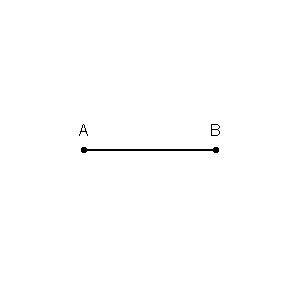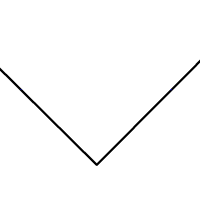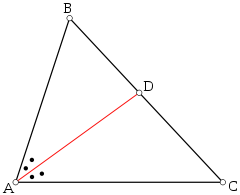Bisection

In geometry, bisection is the division of something into two equal or congruent parts, usually by a line, which is then called a bisector. The most often considered types of bisectors are the segment bisector (a line that passes through the midpoint of a given segment) and the angle bisector (a line that passes through the apex of an angle, that divides it into two equal angles).
In three-dimensional space, bisection is usually done by a plane, also called the bisector or bisecting plane.
Line segment bisector

A line segment bisector passes through the midpoint of the segment. Particularly important is the perpendicular bisector of a segment, which, according to its name, meets the segment at right angles. The perpendicular bisector of a segment also has the property that each of its points is equidistant from the segment's endpoints. Therefore, Voronoi diagram boundaries consist of segments of such lines or planes.
In classical geometry, the bisection is a simple compass and straightedge construction, whose possibility depends on the ability to draw circles of equal radii and different centers. The segment is bisected by drawing intersecting circles of equal radius, whose centers are the endpoints of the segment and such that each circle goes through one endpoint. The line determined by the points of intersection of the two circles is the perpendicular bisector of the segment, since it crosses the segment at its center. This construction is in fact used when constructing a line perpendicular to a given line at a given point: drawing an arbitrary circle whose center is that point, it intersects the line in two more points, and the perpendicular to be constructed is the one bisecting the segment defined by these two points.
Brahmagupta's theorem states that if a cyclic quadrilateral is orthodiagonal (that is, has perpendicular diagonals), then the perpendicular to a side from the point of intersection of the diagonals always bisects the opposite side.
Angle bisector

An angle bisector divides the angle into two angles with equal measures. An angle only has one bisector. Each point of an angle bisector is equidistant from the sides of the angle.
The interior or internal bisector of an angle is the line, half-line, or line segment that divides an angle of less than 180° into two equal angles. The exterior or external bisector is the line that divides the supplementary angle (of 180° minus the original angle), formed by one side forming the original angle and the extension of the other side, into two equal angles.[1]
To bisect an angle with straightedge and compass, one draws a circle whose center is the vertex. The circle meets the angle at two points: one on each leg. Using each of these points as a center, draw two circles of the same size. The intersection of the circles (two points) determines a line that is the angle bisector.
The proof of the correctness of these two constructions is fairly intuitive, relying on the symmetry of the problem. It is interesting to note that the trisection of an angle (dividing it into three equal parts) cannot be achieved with the compass and ruler alone (this was first proved by Pierre Wantzel).
Triangle

Concurrencies and collinearities
The interior angle bisectors of a triangle are concurrent in a point called the incenter of the triangle, as seen in the diagram at right.
The bisectors of two exterior angles and the bisector of the other interior angle are concurrent.[2]:p.149
Three intersection points, each of an external angle bisector with the opposite extended side, are collinear (fall on the same line as each other).[2]:p. 149
Three intersection points, two of them between an interior angle bisector and the opposite side, and the third between the other exterior angle bisector and the opposite side extended, are collinear.[2]:p. 149
Angle bisector theorem

The angle bisector theorem is concerned with the relative lengths of the two segments that a triangle's side is divided into by a line that bisects the opposite angle. It equates their relative lengths to the relative lengths of the other two sides of the triangle.
Lengths
If the side lengths of a triangle are , the semiperimeter and A is the angle opposite side , then the length of the internal bisector of angle A is[2]:p. 70
or in trigonometric terms,[3]
If the internal bisector of angle A in triangle ABC has length and if this bisector divides the side opposite A into segments of lengths m and n, then[2]:p.70
where b and c are the side lengths opposite vertices B and C; and the side opposite A is divided in the proportion b:c.
If the internal bisectors of angles A, B, and C have lengths and , then[4]
No two non-congruent triangles share the same set of three internal angle bisector lengths.[5][6]
Integer triangles
There exist integer triangles with a rational angle bisector.
Quadrilateral
The internal angle bisectors of a convex quadrilateral either form a cyclic quadrilateral (that is, the four intersection points of adjacent angle bisectors are concyclic),[7] or they are concurrent. In the latter case the quadrilateral is a tangential quadrilateral.
Rhombus
Each diagonal of a rhombus bisects opposite angles.
Ex-tangential quadrilateral
The excenter of an ex-tangential quadrilateral lies at the intersection of six angle bisectors. These are the internal angle bisectors at two opposite vertex angles, the external angle bisectors (supplementary angle bisectors) at the other two vertex angles, and the external angle bisectors at the angles formed where the extensions of opposite sides intersect.
Parabola
The tangent to a parabola at any point bisects the angle between the line joining the point to the focus and the line from the point and perpendicular to the directrix.
Bisectors of the sides of a polygon
Triangle
Medians
Each of the three medians of a triangle is a line segment going through one vertex and the midpoint of the opposite side, so it bisects that side (though not in general perpendicularly). The three medians intersect each other at the centroid of the triangle, which is its center of mass if it has uniform density; thus any line through a triangle's centroid and one of its vertices bisects the opposite side. The centroid is twice as close to the midpoint of any one side as it is to the opposite vertex.
Perpendicular bisectors
The interior perpendicular bisector of a side of a triangle is the segment, falling entirely on and inside the triangle, of the line that perpendicularly bisects that side. The three perpendicular bisectors of a triangle's three sides intersect at the circumcenter (the center of the circle through the three vertices). Thus any line through a triangle's circumcenter and perpendicular to a side bisects that side.
In an acute triangle the circumcenter divides the interior perpendicular bisectors of the two shortest sides in equal proportions. In an obtuse triangle the two shortest sides' perpendicular bisectors (extended beyond their opposite triangle sides to the circumcenter) are divided by their respective intersecting triangle sides in equal proportions.[8]:Corollaries 5 and 6
For any triangle the interior perpendicular bisectors are given by and where the sides are and the area is [8]:Thm 2
Quadrilateral
The two bimedians of a convex quadrilateral are the line segments that connect the midpoints of opposite sides, hence each bisecting two sides. The two bimedians and the line segment joining the midpoints of the diagonals are concurrent at a point called the "vertex centroid" and are all bisected by this point.[9]:p.125
The four "maltitudes" of a convex quadrilateral are the perpendiculars to a side through the midpoint of the opposite side, hence bisecting the latter side. If the quadrilateral is cyclic (inscribed in a circle), these maltitudes are concurrent at (all meet at) a common point called the "anticenter".
Brahmagupta's theorem states that if a cyclic quadrilateral is orthodiagonal (that is, has perpendicular diagonals), then the perpendicular to a side from the point of intersection of the diagonals always bisects the opposite side.
The perpendicular bisector construction forms a quadrilateral from the perpendicular bisectors of the sides of another quadrilateral.
Area bisectors and perimeter bisectors
Triangle
There are an infinitude of lines that bisect the area of a triangle. Three of them are the medians of the triangle (which connect the sides' midpoints with the opposite vertices), and these are concurrent at the triangle's centroid; indeed, they are the only area bisectors that go through the centroid. Three other area bisectors are parallel to the triangle's sides; each of these intersects the other two sides so as to divide them into segments with the proportions .[10] These six lines are concurrent three at a time: in addition to the three medians being concurrent, any one median is concurrent with two of the side-parallel area bisectors.
The envelope of the infinitude of area bisectors is a deltoid (broadly defined as a figure with three vertices connected by curves that are concave to the exterior of the deltoid, making the interior points a non-convex set).[10] The vertices of the deltoid are at the midpoints of the medians; all points inside the deltoid are on three different area bisectors, while all points outside it are on just one. The sides of the deltoid are arcs of hyperbolas that are asymptotic to the extended sides of the triangle.[10] The ratio of the area of the envelope of area bisectors to the area of the triangle is invariant for all triangles, and equals i.e. 0.019860... or less than 2%.
A cleaver of a triangle is a line segment that bisects the perimeter of the triangle and has one endpoint at the midpoint of one of the three sides. The three cleavers concur at (all pass through) the center of the Spieker circle, which is the incircle of the medial triangle. The cleavers are parallel to the angle bisectors.
A splitter of a triangle is a line segment having one endpoint at one of the three vertices of the triangle and bisecting the perimeter. The three splitters concur at the Nagel point of the triangle.
Any line through a triangle that splits both the triangle's area and its perimeter in half goes through the triangle's incenter (the center of its incircle). There are either one, two, or three of these for any given triangle. A line through the incenter bisects one of the area or perimeter if and only if it also bisects the other.[11]
Parallelogram
Any line through the midpoint of a parallelogram bisects the area[12] and the perimeter.
Circle and ellipse
All area bisectors and perimeter bisectors of a circle or other ellipse go through the center, and any chords through the center bisect the area and perimeter. In the case of a circle they are the diameters of the circle.
Bisectors of diagonals
Parallelogram
The diagonals of a parallelogram bisect each other.
Quadrilateral
If a line segment connecting the diagonals of a quadrilateral bisects both diagonals, then this line segment (Newton Line) is itself bisected by the vertex centroid.
Volume bisectors
A plane that divides two opposite edges of a tetrahedron in a given ratio also divides the volume of the tetrahedron in the same ratio. Thus any plane containing a bimedian (connector of opposite edges' midpoints) of a tetrahedron bisects the volume of the tetrahedron[13][14]:pp.89–90
References
- ↑ Weisstein, Eric W. "Exterior Angle Bisector." From MathWorld--A Wolfram Web Resource.
- 1 2 3 4 5 Johnson, Roger A., Advanced Euclidean Geometry, Dover Publ., 2007 (orig. 1929).
- ↑ Oxman, Victor. "On the existence of triangles with given lengths of one side and two adjacent angle bisectors", Forum Geometricorum 4, 2004, 215–218. http://forumgeom.fau.edu/FG2004volume4/FG200425.pdf
- ↑ Simons, Stuart. Mathematical Gazette 93, March 2009, 115-116.
- ↑ Mironescu, P., and Panaitopol, L., "The existence of a triangle with prescribed angle bisector lengths", American Mathematical Monthly 101 (1994): 58–60.
- ↑ Oxman, Victor, "A purely geometric proof of the uniqueness of a triangle with prescribed angle bisectors", Forum Geometricorum 8 (2008): 197–200.
- ↑ Weisstein, Eric W. "Quadrilateral." From MathWorld--A Wolfram Web Resource. http://mathworld.wolfram.com/Quadrilateral.html
- 1 2 Mitchell, Douglas W. (2013), "Perpendicular Bisectors of Triangle Sides", Forum Geometricorum 13, 53-59.
- ↑ Altshiller-Court, Nathan, College Geometry, Dover Publ., 2007.
- 1 2 3 Dunn, J. A., and Pretty, J. E., "Halving a triangle," Mathematical Gazette 56, May 1972, 105-108.
- ↑ Kodokostas, Dimitrios, "Triangle Equalizers," Mathematics Magazine 83, April 2010, pp. 141-146.
- ↑ Dunn, J. A., and J. E. Pretty, "Halving a triangle", Mathematical Gazette 56, May 1972, p. 105.
- ↑ Weisstein, Eric W. "Tetrahedron." From MathWorld--A Wolfram Web Resource. http://mathworld.wolfram.com/Tetrahedron.html
- ↑ Altshiller-Court, N. "The tetrahedron." Ch. 4 in Modern Pure Solid Geometry: Chelsea, 1979.
External links
- The Angle Bisector at cut-the-knot
- Angle Bisector definition. Math Open Reference With interactive applet
- Line Bisector definition. Math Open Reference With interactive applet
- Perpendicular Line Bisector. With interactive applet
- Animated instructions for bisecting an angle and bisecting a line Using a compass and straightedge
- Weisstein, Eric W. "Line Bisector". MathWorld.
This article incorporates material from Angle bisector on PlanetMath, which is licensed under the Creative Commons Attribution/Share-Alike License.